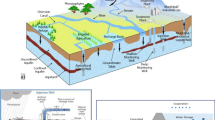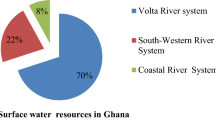Abstract
Hanjiang river is the longest river in Yangtze river basin, having high economic importance to China for its economically exploitable hydropower and potential water resources. In an attempt to satisfy China’s economic and social development needs, the Chinese government has established cascade dams and four relative water diversion projects in Hanjiang river, which aims at transferring water from south (Hanjiang river) to north (water-stricken areas). However, there are increasing eco-environmental concerns associated with the establishment and development of cascade hydropower. In this study, the opportunities and eco-environmental influences related to Hanjiang river’s cascade hydropower development are explored and then recommendations are put forward to minimize the potential impacts. The implementation of vigorous projects related to hydropower and water diversion has an important role to play in solving flood, energy and water shortage problems. In addition, the eco-environmental and socio-economic impacts on the middle and downstream and its diversion can be relieved to some degree in the area. However, the establishment of projects can cause several impacts on the local eco-environment. First, Danjiangkou reservoir construction can cause change in water flow, water bloom, soil erosion in the river basin. Second, it can directly lead to the decrease of 10.5 billion cubic meters of water in the middle- and downstream areas, threatening the local supply of drinking water and influencing farming irrigation and industrial production. Finally, the construction of cascade hydropower dams can change the water form and fish stocks may reduce threatening eco-environment security and environmental geology.
Similar content being viewed by others
References
Alexander, S.K., Michael, D.M. and Weathers, H.D. (2012) Depositional dynamics in a river diversion receiving basin: The case of the West Bay Mississippi River Diversion. Estuarine, Coastal and Shelf Science, v.xxx, pp.1–12.
Alison, B. (2002) Hydropower potential and development activities. Energy Policy, v.(30), pp.1231–1239.
Amy, M.N., Darrin, M. and Aaron, T.W. (2009) Hydropower and sustainability: Resilience and vunerability in China’s powersheds. Jour. Environ. Managmt., v.90, pp.S286–S293.
BAIDU IMAGE. (2012a) Danjiangkou Reservoir [Internet]. [cited 2012 Jul7 31]. Available from: http://image.baidu.com/
BAIDU IMAGE. (2012b) Ankang Reservoir [Internet]. [cited 2012 Jul7 31] Available from:http://image.baidu.com/
Chang, F.X., Chen, J. and Zhang, Z.Y. (2007) Environmental Water Demand in Upstream of Hanjiang River. Jour. Yangtze River Scientific Res. Inst., v.24(6), pp.18–21 (in Chinese).
Chang, X.L. (2009) Hydropower in China at present and its further development. Energy, v.35, pp.4400–4406.
Chen, H., Guo, S.L., Xu, C.Y. and Vijay, P.S. (2007) Historical temporal trends of hydro-climatic variables and runoff response to climate variability and their relevance in water resource management in the Hanjiang basin. Jour. Hydrology, v.344, pp.171–184.
Chen, J., Zhang, W.S. and Fang, F. (2009) Study the Impact of Efficient Environment Capacity after South-to-north Water Transfer Project in the Middle-lower Stream Areas of Han River. Environ. Sci. Tech., v.32(Special), pp.135–139 (in Chinese).
Cristina, F., José, A.V. and Teresa, F. (2012) The effects of fuel reduction treatments on runoff, infiltration and erosion in two shrubland areas in the north of Spain. Jour. Environ. Managmt., v.(105), pp.96–102.
David, C. (2008) Lubomirsky lgor. Energy, the global challenge, and materials. Materials Today, v.11(12), pp.16–20.
Fang, Y.P. and Deng, W. (2011) The critical scale and section management of cascade hydropower exploitation in Southwestern China. Energy, v.36, pp.5944–5953.
Georg, C. (2009) Gauging the future competitiveness of renewable energy in Colombia. Energy Economics, v.31(3), pp.443–449.
Guo, Z.X. (1981) Hydroelectric resources and its exploitation in China. Railway Technology Dynamic, pp.8–12.
Huang, T.M. and Pang, Z.H. (2009) Changes in groundwater induced by water diversion in the Lower Tarim River, Xinjiang Uygur, NW China: Evidence from environmental isotopes and water chemistry. Jour. Hydrol., v.387, pp.188–201.
Hu, Z.F. and Zhang, L.P. (2008) Effect of Median-line South-to-North Water Transfer Project on Water Environment in Middle and Lower Reaches of Hanjiang River. Jour. Water Resourc. and Architechtural Engg., v.6(3), pp.15–17 (in Chinese).
Jiang, G.Z. and Han, X.B. (1998) Environmental impact analysis of the middle and lower reaches of the cascade development. Environ. Sci. Tech., v.4, pp.14–16 (in Chinese).
Kari, L.V. and Juliann, E.A. (2012) A Comparison of tools for modeling freshwater ecosystem services. Jour. Environ. Managmt., v.92, pp.2403–2409.
Lu, G.B., Liu, Y., Zou, X.L., Zou, Z.H. and Cai, T. 2009. Impact of the Danjiangkou reservoir on the flow regime in the middle and lower reaches of Hanjiang River. Resources and Environment in the Yangtze Basin, v.18(10), pp.959–963 (in Chinese).
Luan, C.Q., Tang, Y.Q., Jia, Y.J. and Cui, Z.D. (2007) Influence of Water Level of Shuhe Hydraulic Power Station on Reservoir Bank Stability. Jour. Catastrophology, v.22(1), pp.65–68 (in Chinese).
Lucas, J.S., Patrizia, A., Birgitta, B., Klaus, B., John, R.G., Paul, K.H., Kaarina, S. and Anthony, E.W. (2003) BASIC: Baltic Sea cyanobacteria. An investigation of the structure and dynamics of water blooms of cyanobacteria in the Baltic Searesponses to a changing environment. Continental Shelf Res., v.23, pp.1695–1714.
Mehmet, B. (2010) Hydropower potential and environmental effects of multidam hydropower projects in Turkey. Energy for Sustainable Development, v.14, pp.320–329.
Pan, J.Z. (2004) Hydropower and China. Water Power, v.30(12), pp.17–21 (in Chinese).
Peng, H., Guo, S.L. and Ni, Y.Q. (2002) The study of water ecological environment demand in the middle and lower of Hanjiang River. China water resources association conference on academic. pp.95–98 (in Chinese).
Robin F. Warner (2012) Environmental impacts of hydroelectric power and other anthropogenic developments on the hydromorphology and ecology of the Durance channel and the Etang de Berre, southeast France. Jour. Environ. Managmt., v.104, pp.35–50.
Se Woong Chung, Ick Hwan Ko and Yu Kyung Kim. (2008) Effect of reservoir flushing on downstream river water quality. Jour. Environ. Managmt., v.86, pp.139–147.
Shan, S.B. and Geng, W.D. 2002. The necessity and urgency of the North Water Transfer Project Construction. South-to-North Water Diversion and Water Science and Technology, v.23(3), pp.13–15 (in Chinese).
Shen, H.L., Xu, Y.Y., Wang, L., Zhang, M., Kong, L.H. and Cai, Q.H. (2011) Spatial and Temporal Variations of Phytoplankton in Danjiangkou Reservoir and its Affecting Factors. Plant Science Jour. v.29(6), pp.683–690 (in Chinese).
Wang, T.T., Zhang, W.S., Peng, H, Wang, Y. and Zhu, Q.Y. (2007) Effect of the Water Transfer Project from Yangtze River to Hangjiang River on the Eco-environment of the Middle and Lower Reaches of Hanjiang Rive. Research of Soil and Water Conservation, v.14(4), pp.40–43 (in Chinese).
Wu, X.W., Wei, X.D. and Guo, W. (2012) Multi-objective Ecological Operation Model of Cascade Hydropower Reservoirs. Procedia Engg., v.29, pp.3996–4001.
Xiao, C., Xie, P., Tang, T. and Chen, L. (2009) Influence of Middle Route of South-to-North Water Diversion Project on Hydrological Regime in Middle and Lower Reaches of Hanjiang River. Jour. China Hydrol., v.29(1), pp.26–29 (in Chinese).
Xie, P., Xia, J., Dou, M. and Zhang, W.S. 2004. Research into the effects of the middle route of China’s south-to-north water transfer projeet on water bloom in the middle-downstream of Hanjiang River and the countermeasures Part I: An analysis of the key factors generating water bloom in Hanjiang River. Environ. Sci. Tech., v.19(4), pp.418–423 (in Chinese).
Yan, G.J. (2009) Comprehensive research and development of Hanjiang River in Hubei province, China. Research Press, pp.3–37 (in Chinese).
Yang, Q., Xie, P., Shen, H., Xu, J., Wang, P.L. and Zhang, B. 2012. A novel flushing strategy for diatom bloom prevention in the lower-middle Hanjiang River. Water Res., v.(46), pp.2525–2534.
Zhang, Z.W. (2005) Effect of the M iddle Route of Chinese South to North W ater Transfer Project on Xiangfan City of the Middle Reaches of the Hanjiang River. Jour. Xiangfan Vocational and Technical College, v.4(6), pp.111–113 (in Chinese).
Zhu, L.D, Li, Z.H. and Ketola, T. (2011) Biomass accumulations and nutrient uptake of plants cultivated on artificial floating beds in China’s rural area. Ecological Engg., v.37, pp.1460–1466.
Zhu, L.D. and Ketola, T. (2012) Microalgae production as a biofuel feedstock: risks and challenges. Internat. Jour. Sustainable Development & World Ecology, v.19(3), pp.268–274.
Zhu, T.R., Yang, F.L., Bai, Y. and Wu, Y.M. (2009) Forecasting of Bed Erosion Induced by Cuijiaying Navigation and Hydropower Junctions at the Hanjiang River. China Rural Water and Hydropower, v.1, pp.8–10 (in Chinese).
Author information
Authors and Affiliations
Corresponding author
Rights and permissions
About this article
Cite this article
Li, BS., Zhou, PJ., Wang, XY. et al. Opportunities and eco-environmental influence of cascade hydropower development and water diversion projects in Hanjiang river basin. J Geol Soc India 82, 692–700 (2013). https://doi.org/10.1007/s12594-013-0207-3
Received:
Revised:
Published:
Issue Date:
DOI: https://doi.org/10.1007/s12594-013-0207-3




